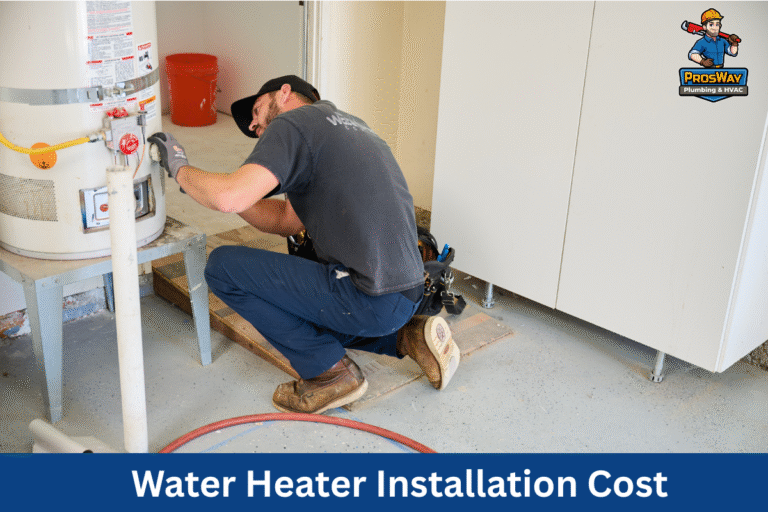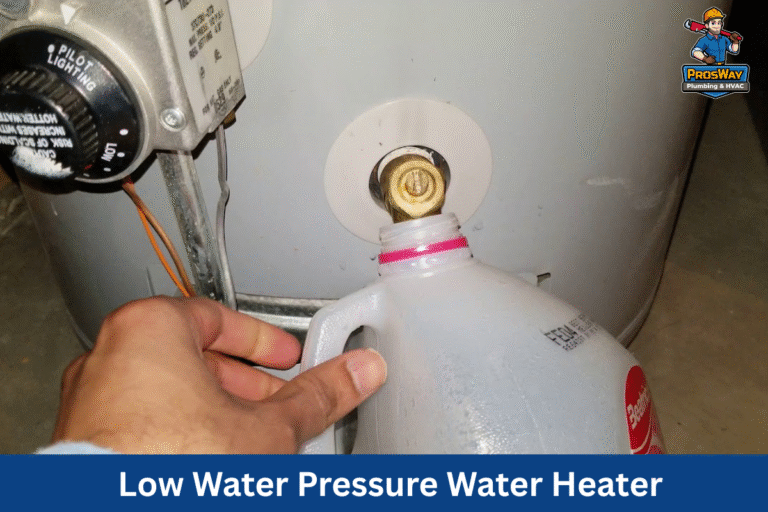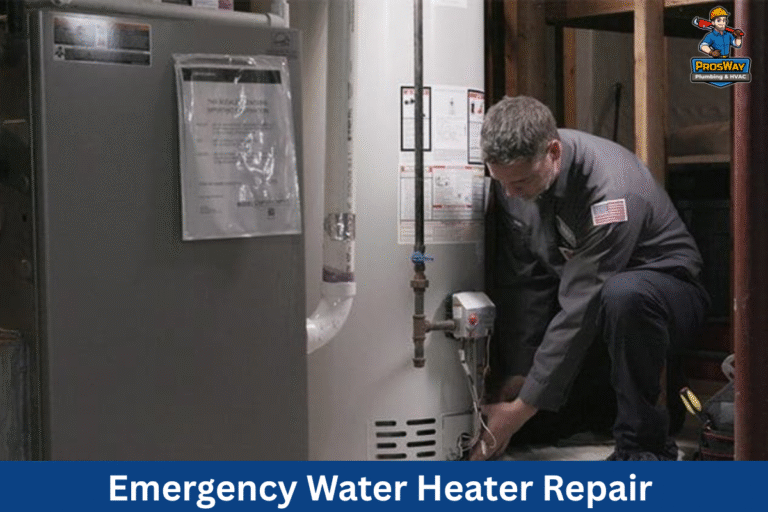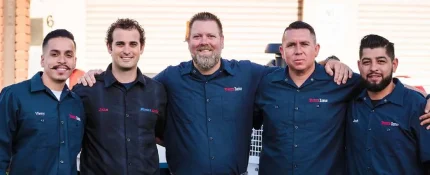At ProsWay Plumbing & HVAC, we know that understanding what drives sewer repair pricing can help homeowners in Northern New Jersey make smarter, more budget-conscious decisions. Several factors impacting sewer line repair costs, such as pipe age, location complexity, and the method of repair, can significantly influence your total expenses.
In this guide, we break down how variables like trenchless technology, leak detection, and permit fees affect your project cost. Whether it’s a minor fix or full pipe replacement, we explain what to expect and how local conditions, labor rates, and contractor expertise contribute to the overall price.
How Do Pipe Characteristics Influence Sewer Line Repair Expenses?
The physical properties of your sewer line are critical when estimating repair costs. The materials, age, and construction techniques used in a sewer pipe all affect its durability and vulnerability.
Older pipes made from cast iron or clay behave differently from modern polyvinyl chloride (PVC) or acrylonitrile butadiene styrene (ABS) pipes. Homeowners with resin-coated or copper-infused pipes might have different repair challenges.
What Is the Impact of Pipe Age and Material Composition?
The age of the sewer line is a major factor in determining repair cost. Many older homes in Northern New Jersey still use pipes made from clay or cast iron.
These materials are prone to corrosion and wear over time. Newer houses typically use trenchless sewer line technology with modern PVC or ABS, which are more resilient to root intrusion and leaks.
Older materials may require complete replacement rather than a simple patch-up. Scientific research shows that corrosion can reduce the lifespan of metal pipes by approximately 20%.
Diameter and Total Length of the Damaged Sewer Line
The size of the sewer pipe plays a role in repair costs because larger pipes require more materials, labor, and equipment. A small residential line may have a diameter of 4–6 inches, while municipal or commercial systems have even larger diameters.
The greater the length of the damaged line, the higher the cost due to increased labor and material requirements.
For example, a 50-foot repair might cost drastically less than a 200-foot replacement. Factors such as the number of pipe joints and the complexity of the pipeline’s layout further influence the overall repair expense.
What Role Does the Severity and Nature of Pipe Damage Play?
Minor cracks and leaks, which can be remedied with epoxy resin repairs, cost considerably less than major breakdowns such as pipe collapses. The extent of deterioration may require advanced methods like pipe bursting or full replacement of the damaged section.
In some cases, even a localized repair might expose hidden issues like root intrusions or misaligned joints, leading to additional costs. A detailed inspection, often with a sewer camera video, helps determine the severity and directs the repair strategy.
How Does Location and Accessibility Determine Project Complexity?

The accessibility of the sewer line largely influences repair pricing. Homeowners may face challenges in accessing underground pipelines that are located under buildings, pavement, or landscaped areas.
When a sewer line lies under a heavily trafficked roadway or near essential utilities, repair work becomes more complicated. Accessibility issues often increase labor hours and require specialized equipment, which, in turn, drives up the cost.
Depth of the Sewer Line Installation
The depth at which your sewer line is buried affects excavation needs and repair difficulty. Deeper pipes involve more extensive digging, which can lead to higher costs.
In areas with colder climates like Northern New Jersey, deeper installations may be necessary to avoid frost damage, further increasing the complexity of repairs.
When a pipe is located several feet below the surface, contractors must plan for safe, controlled excavation and soil management techniques.
Why Does Proximity to Other Utilities and Structures Matter?
When sewer lines run close to other critical infrastructures, such as water lines, electrical conduits, and building foundations, the risk of inadvertent damage during repair increases.
This closeness can complicate repairs because workers must carefully navigate around these systems. For instance, cutting through a pavement that hides important structures might necessitate additional inspections or even protective measures like temporary supports.
Utility companies might need to be involved, adding to both the expense and project duration.
Presence of Obstacles Like Tree Roots or Pavement
Tree roots are a common issue affecting older sewer lines. They can infiltrate the pipe through small fissures, causing blockages and structural damage. Removing these roots without damaging the pipe is challenging, and special equipment may be required to eradicate them effectively.
Similarly, repairing pipes beneath concrete or asphalt demands careful removal of pavement, followed by restoration once the repair is complete. This process adds significant material and labor costs to the overall project.
How Does the Chosen Repair Method Affect Sewer Line Repair Costs?
The selected repair method is one of the most significant factors impacting sewer line repair costs. Homeowners can opt for traditional excavation repairs or more modern trenchless solutions, each with its advantages and drawbacks.
Traditional repairs involve fully exposing the pipe and manually fixing or replacing damaged sections. In contrast, trenchless methods such as pipe relining or pipe bursting minimize surface disruption and typically require less excavation.
Cost Comparison of Traditional Excavation Repairs
Traditional excavation repairs are often the most straightforward method when damage is isolated. However, the cost can increase quickly if a large area must be dug up and restored.
Traditional methods require labor-intensive processes that involve heavy machinery, backfill material, concrete replacement, and potential landscaping repair.
For instance, excavating an entire yard to repair a pipe can approach or exceed several thousand dollars in Northern New Jersey.
What Are Pricing Elements for Trenchless Pipe Lining Options?
Trenchless sewer repair, which involves inserting a new liner into the existing pipe, often offers a less disruptive and faster alternative. Although the initial cost per linear foot might be higher, the overall expense may be lower since there is minimal excavation required.
This method is ideal for the repair of long sections of pipe with minor cracks rather than full replacement. Studies have indicated that trenchless repair techniques can reduce overall project time by up to 40% compared to traditional methods.
Which Expense Factors Are Associated With Pipe Bursting Methods?
Pipe bursting is another trenchless option that involves breaking the old pipe apart and replacing it with a new one without significant digging. This method is particularly useful for pipes that have collapsed or have severe root damage.
However, pipe bursting also has potential downsides, such as the need for a larger replacement pipe and high equipment costs. It is most cost-effective when dealing with single, long-standing lines rather than multiple segmented issues.
Watch this video for more insights: Trenchless Sewer Replacement: How PIPE BURSTING Works.
Financial Difference Between Spot Repairs and Full Replacement
In some cases, only a localized section of a sewer line is damaged, and a spot repair might suffice. Spot repairs are generally less expensive as they target a small area of impact, whereas full pipe replacements involve entire sections of the system and typically incur a higher overall cost.
Determining whether a spot repair or a complete replacement is needed involves a detailed inspection, often using video cameras, to diagnose the full extent of the damage. Homeowners should consider long-term durability when choosing between these options.
Below is a table comparing the cost factors of different repair methods:
| Repair Method | Labor Intensity | Surface Disruption | Average Cost per Foot | Recovery Time |
|---|---|---|---|---|
| Traditional Excavation | High | High | $150–$250 | 2–3 weeks |
| Trenchless Pipe Lining | Medium | Low | $200–$300 | 1–2 weeks |
| Pipe Bursting | Medium | Low | $250–$350 | 1–2 weeks |
| Spot Repair | Low | Low | Varies (localized) | 1 week |
| Full Replacement | High | High | $300 and above | 3+ weeks |
How Does the Extent of Damage Influence Sewer Line Repair Costs?

The extent and type of damage to a sewer line directly dictate the magnitude of repair investment. Minor issues like small cracks or localized root intrusion may only require minimal intervention.
Conversely, severe damage, such as a complete pipe collapse, necessitates extensive repairs or even full replacement. Evaluating the scope of the problem is critical for budgeting and planning the repair work effectively.
Repairing Minor Cracks Versus Complete Pipe Collapse
Minor cracks and leaks, though they might seem inconsequential, can lead to significant water waste and structural damage over time. Fixing small cracks can involve applying a resin patch or using epoxy injections designed for home improvement repairs. These less invasive measures are generally low-cost.
However, when a pipe collapses entirely due to years of neglect or severe weathering, the repair costs can skyrocket. Full replacement of a collapsed sewer line involves significant digging, removal of the old pipe, and installation of a new one, leading to a much higher price tag.
Addressing Costs Related to Significant Root Intrusion
Tree roots are a common culprit behind sewer line issues. When roots infiltrate pipe joints and cling to the inside of the pipe, they can cause continuous blockages and deterioration. Repairing these types of damage often means cutting away the roots.
And applying a root-killing chemical, followed by a relining process to restore structural integrity. The cost here is twofold: first, the removal of harmful roots, and second, the cost of the actual repair or replacement process. This dual-step process increases both labor and material expenses.
What Are the Fixing Separated or Misaligned Pipe Joint Expenses?
Separations or misalignments between pipe sections are another common problem. These issues may result from soil movement, poor original installation, or wear and tear over time.
Repairing a misaligned joint often requires precise adjustments and may involve cutting out the faulty section and reconnecting it using new fittings.
The complexity of this work usually means higher labor costs and increased repair time. Such repairs are crucial to prevent future leaks and ensure a reliable wastewater drainage system.
The following list outlines common repair scenarios along with detailed explanations and associated costs:
- Minor Crack Repair: Applying epoxy resin to small cracks can quickly restore pipe integrity. This method is effective and low-cost, ensuring that minor leaks do not develop into larger problems. The cost is usually minimal and can be performed in less than a day.
- Localized Root Removal: When roots begin to intrude, contractors may use trimmers or chemical treatments to remove them. This process, combined with a patch repair, resolves the immediate issue and prevents recurrence.
- Pipe Relining for Sagging Sections: Using a trenchless lining method, contractors insert a new resin-coated tube into the damaged pipe. This innovative solution repairs the pipe without the need for extensive excavation and is pricey but effective.
- Full Pipe Replacement Due to Collapse: In cases where the pipe has completely collapsed, a full replacement is required. This involves significant labor, equipment, and material expenditures, making it the most expensive option.
- Joint Correction and Reconnection: Fixing misaligned joints involves precise measurements and careful reconnection of pipe sections. This targeted repair ensures proper alignment and prevents further damage from recurring separations.
How Do Geographic Location and Local Regulations Affect Repair Pricing?
Geographic location and local building codes play a crucial role in determining sewer line repair costs. Different regions impose varying labor rates, permit fees, and regulatory requirements.
In Northern New Jersey, for instance, local municipalities have strict standards that contractors must follow, which can drive up the overall expense.
Understanding these regional differences is key for homeowners when planning repairs and budgeting accordingly.
Regional Variations in Labor Rates and Material Supply Costs
Labor rates can differ significantly by region. In areas with a high cost of living or in densely populated regions like Northern New Jersey, you may encounter higher hourly rates for professional plumbing services.
Similarly, material costs such as resin, epoxy, and replacement piping can fluctuate depending on local demand and supply chain influences.
In some cases, contractors might source materials from nearby suppliers, which can either lower or raise the tariff depending on the quality and availability of the product.
Why Are Permits and Municipal Inspection Fees Necessary?
Homeowners rarely realize that sewer line repairs often require permits and subsequent inspections by local authorities. Municipal fees can vary widely; some municipalities may charge a standard fee per linear foot of pipe repaired, while others might impose a flat rate.
Inspection processes add both time and money to the overall project. For example, if a permit is required before any work begins, this may result in an additional cost that can range from a few hundred to over a thousand dollars in some instances.
Waste Disposal and Soil Management Charges
During sewer repairs, waste disposal is a significant cost component. Excavated materials, removed pipes, and the soil disturbed during repair require proper disposal according to state regulations. In many areas, contractors must pay fees to dispose of waste in environmentally controlled facilities.
Soil stabilization might be necessary if the excavation significantly disturbs the ground, particularly on properties with sensitive landscaping or proximity to building foundations.
This extra work ensures that the area is restored properly and complies with local environmental regulations.
Below is a table detailing various local cost factors that influence repair pricing:
| Factor | Impact on Cost | Typical Additional Cost | Importance in Northern New Jersey |
|---|---|---|---|
| Labor Rates | High | $100-$150 per hour | Significant due to dense urban areas |
| Material Costs | Variable | $2-$5 per foot of pipe | Affected by regional supply chain |
| Permit Fees and Inspections | High | $300-$1000 per project | Strict local regulations in NJ |
| Waste Disposal | Moderate | $200-$500 per project | Ensures compliance with environmental codes |
| Soil Stabilization | Moderate | $250-$600 per project | Necessary on properties with landscaping |
What Contractor Factors Influence Sewer Line Repair Costs?

The final pricing of sewer line repairs largely depends on selecting the right contractor and determining additional services that may be necessary. In any repair project, the contractor’s experience, reputation, and the range of services they offer play a pivotal role in the outcome and cost.
Local experts like those at ProsWay Plumbing & HVAC, serving Northern New Jersey, often provide transparent quotes and reliable work that justify their fees.
How Do Experience and Reputation Affect Pricing?
In choosing a contractor, experience is key. A well-established plumbing company with a proven track record is more likely to offer an accurate assessment of repair needs. They can better predict unforeseen issues and minimize delays during the project.
Companies with a long history in the area tend to have strong relationships with local suppliers, which can lead to better pricing on materials. While an established contractor might charge a premium for their expertise, the overall value they offer through high-quality workmanship and reliable service often justifies this additional cost.
Expense of Initial Sewer Camera Video Inspections
Before any repair begins, a comprehensive inspection is typically performed with a sewer camera to assess the extent of damage. This process is crucial for identifying issues that might not be visible through traditional methods.
Although this inspection adds an extra fee to the total project cost, this upfront expense can save homeowners significant money in the long term by providing an accurate diagnosis and ensuring the chosen repair method is appropriate.
How Do Site Restoration Needs Add to Expenses?
After the sewer repair, the site must often be restored to its original condition. This may involve repaving driveways, repairing sidewalks, or restoring landscaping that was disturbed during excavation. The expense for site restoration is in addition to the repair work and is usually calculated separately.
Contractors provide estimates for these services based on the extent of disruption. For instance, a project that requires significant urban landscaping restoration might add several hundred dollars to the overall price, ensuring that the property looks undisturbed once the work is completed.
Frequently Asked Questions
How do I know which sewer repair method is best for my home?
The best method depends on the extent of damage, pipe material, location, and accessibility. An inspection, often with a sewer camera, provides insight into whether a spot repair, trenchless technique, or full replacement is needed.
Can trenchless sewer repair reduce disruption to my property?
Yes, trenchless sewer repair reduces surface disruption and excavation. This method minimizes the need to remove pavement or landscaping, making it a less disruptive and often more cost-effective alternative.
What factors determine the overall cost of sewer line repairs?
Key factors include the age and material of the pipe, the extent and accessibility of the repair location, local labor rates, permit fees, and contractor expertise. Each element plays a significant role in pricing.
How does geographic location affect sewer repair costs?
Geographic location influences labor rates, permit fees, and material costs. In regions like Northern New Jersey, higher living costs and strict building codes can lead to increased repair expenses compared to less urban areas.
Final Thoughts
Factors impacting sewer line repair costs include the pipe’s physical characteristics, accessibility, chosen repair method, extent of damage, local regulations, and contractor services. Homeowners should carefully assess all these aspects to plan and budget effectively. Understanding these elements can help you make informed decisions that ensure a reliable, cost-effective repair. We encourage you to contact local experts like ProsWay Plumbing & HVAC for a professional assessment tailored to your home’s specific needs.
Need Clarity on Sewer Line Repair Costs? Call ProsWay
Let ProsWay Plumbing & HVAC inspect your system and provide a transparent, customized estimate. We’ll help you understand all factors impacting sewer line repair costs so you can plan confidently. Call us now at (862) 260-5870 or Book Online to schedule your professional assessment!









